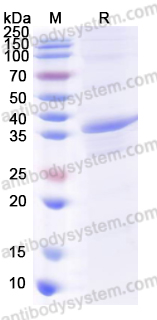Catalog No.
YHB72401
Expression system
E. coli
Species
Homo sapiens (Human)
Protein length
Ser35-Glu111
Predicted molecular weight
36.25 kDa
Nature
Recombinant
Endotoxin level
Please contact with the lab for this information.
Purity
>90% as determined by SDS-PAGE.
Accession
O95715
Applications
ELISA, Immunogen, SDS-PAGE, WB, Bioactivity testing in progress
Form
Lyophilized
Storage buffer
Lyophilized from a solution in PBS pH 7.4, 0.02% NLS, 1mM EDTA, 4% Trehalose, 1% Mannitol.
Reconstitution
Reconstitute in sterile water for a stock solution.
Shipping
In general, proteins are provided as lyophilized powder/frozen liquid. They are shipped out with dry ice/blue ice unless customers require otherwise.
Stability and Storage
Use a manual defrost freezer and avoid repeated freeze thaw cycles. Store at 2 to 8°C for frequent use. Store at -20 to -80°C for twelve months from the date of receipt.
Alternative Names
SCYB14, CXCL14, C-X-C motif chemokine 14, Chemokine BRAK, MIP-2G, NJAC, Small-inducible cytokine B14, MIP2G
Alkaline Treatment Enhances the Anti-inflammatory and Reparative Potential of Dentin Matrix Proteins in Inflamed Pulp., PMID:40484223
CXCL14 Chemokine Exacerbates Acute Viral Hepatitis in Coronavirus MHV-Infected Mice and Is Associated With Human Acute Viral Hepatitis., PMID:40392027
Potential diagnostic marker gene set for non-alcoholic steatohepatitis associated hepatocellular carcinoma with lymphocyte infiltration., PMID:40386252
Hypoxia-induced RHCG as a key regulator in psoriasis and its modulation by secukinumab., PMID:40351602
Expression cloning of cell surface receptors for the CpG oligodeoxynucleotide/CXCL14 complex., PMID:40345012
NAT10 mediated polycystic ovary syndrome through the ac4C modification of CXCL14., PMID:40300667
E2F expression profiling-based subtypes in head and neck squamous cell carcinoma: clinical relevance, prognostic implications, and personalized therapy., PMID:40275315
Dimethyl Itaconate Alleviates Escherichia coli-Induced Endometritis Through the Guanosine-CXCL14 Axis via Increasing the Abundance of norank_f_Muribaculaceae., PMID:40227949
Urine-derived stem cells from patients alleviate lupus nephritis via regulating macrophage polarization in a CXCL14-dependent manner., PMID:40204070
Transitional CXCL14+ cancer-associated fibroblasts enhance tumour metastasis and confer resistance to EGFR-TKIs, revealing therapeutic vulnerability to filgotinib in lung adenocarcinoma., PMID:40162549
Wild-Type TP53 Predicts Poor Prognosis in Lower-Grade Glioma via TP53-CXCL14-GATA3 Axis., PMID:40102292
Chemokine CXCL14 Inhibits the Survival of Mycobacterium smegmatis inside Macrophages by Upregulating A20 to Promote ROS Production., PMID:40100073
Multi-Omics Analysis of Hippocampus in Rats Administered Trimethyltin Chloride., PMID:40095120
CXCL14 regulates ovarian endometriosis progression by targeting PCNA., PMID:40092086
The role and mechanism study of Cxcl14 in chronic critically ill cardiac dysfunction., PMID:40010139
Bystander Expression of Atypical Chemokine Receptor 2 Protects T Cells from Chemoattraction towards Cancer-Associated Fibroblasts., PMID:39931761
Decoding the cytokine code for heart failure based on bioinformatics, machine learning and Bayesian networks., PMID:39909085
Effects of Production System With or Without Growth-Promoting Technologies on Growth and Blood Expression of (Cyto)Chemokines and Heat Shock and Tight Junction Proteins in Bos taurus and indicus Breeds During Summer Season., PMID:39852940
Characterizing the diabetes-induced pathological changes of the mouse lung by single-cell RNA sequencing., PMID:39832739
Epithelial and mesenchymal compartments of the developing bladder and urethra display spatially distinct gene expression patterns., PMID:39798644
CXCL14 in prostate cancer: complex interactions in the tumor microenvironment and future prospects., PMID:39755616
ATF3-mediated transactivation of CXCL14 in HSCs during liver fibrosis., PMID:39358917
The Role of Chemokines in Obesity and Exercise-Induced Weight Loss., PMID:39334887
Integrative Analysis and Validation of a Cancer-associated Fibroblasts Senescence-related Signature for Risk Stratification and Therapeutic Prediction in Esophageal Squamous Cell Carcinoma., PMID:39308671
Nervonic acid triggered ovarian inflammation by inducing mitochondrial oxidative stress to activate NLRP3/ IL-1β pathway., PMID:39181200
Airway Epithelium-derived CXCL14 Promotes Eosinophil Accumulation in Allergic Airway Inflammation., PMID:39141567
Bioinformatic-based Study to Investigate the Structure and Function of Pro-inflammatory Cytokines TNFα and IL-6 Involved in the Pathogenesis of COVID-19., PMID:39118801
Anlotinib potentiates anti-PD1 immunotherapy via transferrin receptor-dependent CD8+ T-cell infiltration in hepatocellular carcinoma., PMID:39095323
Plasma Kallistatin and Progranulin as Predictive Biomarkers of Intraamniotic Inflammation, Microbial Invasion of the Amniotic Cavity, and Composite Neonatal Morbidity/Mortality in Women With Preterm Premature Rupture of Membranes., PMID:39072836
The chemokine Cxcl14 regulates interneuron differentiation in layer I of the somatosensory cortex., PMID:39058591
Qizhu anticancer prescription enhances immunosurveillance of liver cancer cells by regulating p21-dependent secretory phenotypes., PMID:38823657
FGD5 in basal cells induces CXCL14 secretion that initiates a feedback loop to promote murine mammary epithelial growth and differentiation., PMID:38821057
PAX6/CXCL14 regulatory axis promotes the repair of corneal injury by enhancing corneal epithelial cell proliferation., PMID:38750454
Dual roles of HK3 in regulating the network between tumor cells and tumor-associated macrophages in neuroblastoma., PMID:38714539
Predictive Model to Identify the Long Time Survivor in Patients with Glioblastoma: A Cohort Study Integrating Machine Learning Algorithms., PMID:38662286
The p21+ perinecrotic hepatocytes produce the chemokine CXCL14 after a severe acetaminophen overdose promoting hepatocyte injury and delaying regeneration., PMID:38614205
HIIT Promotes M2 Macrophage Polarization and Sympathetic Nerve Density to Induce Adipose Tissue Browning in T2DM Mice., PMID:38540669
Construction and validation of a joint diagnosis model based on random forest and artificial intelligence network for hepatitis B-related hepatocellular carcinoma., PMID:38482416
Analysis of the mucosal chemokines CCL28, CXCL14, and CXCL17 in dry eye disease: An in vitro and clinical investigation., PMID:38453037
Stat3 activation-triggered transcriptional networks govern the early stage of HBV-induced hepatic inflammation., PMID:38440978
The Chemokine CXCL14 as a Potential Immunotherapeutic Agent for Cancer Therapy., PMID:38400076
Differences in Immune Characteristics and Related Gene Expression in Spleen among Ningxiang, Berkshire Breeds and Their Hybrid Pigs., PMID:38397195
CXCL14 as a Key Regulator of Neuronal Development: Insights from Its Receptor and Multi-Omics Analysis., PMID:38338930
Advance in the role of chemokines/chemokine receptors in carcinogenesis: Focus on pancreatic cancer., PMID:38309677
Osteosarcoma Cells Secrete CXCL14 That Activates Integrin α11β1 on Fibroblasts to Form a Lung Metastatic Niche., PMID:38295227
CXCR4 Expression and Cancer-associated Fibroblasts May Play an Important Role in the Invasion of Low-grade Endometrioid Carcinoma., PMID:38289161
Identification of Low-Density Lipoprotein Receptor-Related Protein 1 as a CXCL14 Receptor Using Chemically Synthesized Tetrafunctional Probes., PMID:38289037
Cold exposure modulates potential brown adipokines in humans, but only FGF21 is associated with brown adipose tissue volume., PMID:38247441
Comparative transcriptome analysis reveals potential regulatory mechanisms of genes and immune pathways following Vibrio harveyi infection in red drum (Sciaenops ocellatus)., PMID:38242261
AP-2α/AP-2β Transcription Factors Are Key Regulators of Epidermal Homeostasis., PMID:38237728

